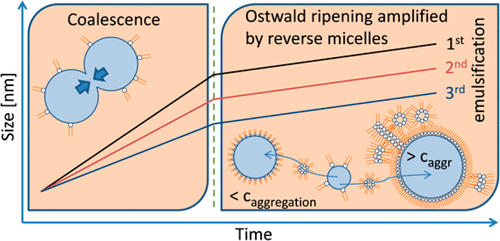Our official English website, www.x-mol.net, welcomes your
feedback! (Note: you will need to create a separate account there.)
Instability Mechanisms of Water-in-Oil Nanoemulsions with Phospholipids: Temporal and Morphological Structures
Langmuir ( IF 3.7 ) Pub Date : 2018-01-03 00:00:00 , DOI: 10.1021/acs.langmuir.7b02852 Jan-Hendrik Sommerling 1, 2 , Maria B. C. de Matos 2, 3 , Ellen Hildebrandt 1, 2 , Alberto Dessy 2 , Robbert Jan Kok 3 , Hermann Nirschl 1 , Gero Leneweit 2, 4
Langmuir ( IF 3.7 ) Pub Date : 2018-01-03 00:00:00 , DOI: 10.1021/acs.langmuir.7b02852 Jan-Hendrik Sommerling 1, 2 , Maria B. C. de Matos 2, 3 , Ellen Hildebrandt 1, 2 , Alberto Dessy 2 , Robbert Jan Kok 3 , Hermann Nirschl 1 , Gero Leneweit 2, 4
Affiliation

|
Many food preparations, pharmaceuticals, and cosmetics use water-in-oil (W/O) emulsions stabilized by phospholipids. Moreover, recent technological developments try to produce liposomes or lipid coated capsules from W/O emulsions, but are faced with colloidal instabilities. To explore these instability mechanisms, emulsification by sonication was applied in three cycles, and the sample stability was studied for 3 h after each cycle. Clearly identifiable temporal structures of instability provide evidence about the emulsion morphology: an initial regime of about 10 min is shown to be governed by coalescence after which Ostwald ripening dominates. Transport via molecular diffusion in Ostwald ripening is commonly based on the mutual solubility of the two phases and is therefore prohibited in emulsions composed of immiscible phases. However, in the case of water in oil emulsified by phospholipids, these form water-loaded reverse micelles in oil, which enable Ostwald ripening despite the low solubility of water in oil, as is shown for squalene. As is proved for the phospholipid dipalmitoylphosphatidylcholine (DPPC), concentrations below the critical aggregation concentration (CAC) form monolayers at the interfaces and smaller droplet sizes. In contrast, phospholipid concentrations above the CAC create complex multilayers at the interface with larger droplet sizes. The key factors for stable W/O emulsions in classical or innovative applications are first, the minimization of the phospholipids’ capacity to form reversed micelles, and second, the adaption of the initial phospholipid concentration to the water content to enable an optimized coverage of phospholipids at the interfaces for the intended drop size.
中文翻译:

具有磷脂的油包水型纳米乳剂的不稳定性机理:时间和形态结构
许多食品制剂,药品和化妆品都使用通过磷脂稳定的油包水(W / O)乳液。而且,近来的技术发展试图由W / O乳剂生产脂质体或脂质包被的胶囊,但是面临胶体不稳定性。为了探索这些不稳定性机理,在三个周期中进行了声波乳化,并在每个周期后的3小时内对样品的稳定性进行了研究。明显可识别的不稳定性的时间结构提供了有关乳液形态的证据:约10分钟的初始状态被证明受聚结控制,此后奥斯特瓦尔德熟化占主导。在奥斯特瓦尔德熟化中,通过分子扩散进行的运输通常基于两相的互溶性,因此在由不混溶相组成的乳液中是被禁止的。然而,对于被磷脂乳化的油中水,它们形成了油中负载水的反胶束,尽管角质烯中的水在油中的溶解度低,但它们仍能使奥斯特瓦尔德熟化。正如磷脂二棕榈酰磷脂酰胆碱(DPPC)所证明的那样,低于临界聚集浓度(CAC)的浓度在界面处形成单层且液滴尺寸较小。相反,高于CAC的磷脂浓度会在界面处形成具有较大液滴尺寸的复杂多层。在经典或创新应用中,稳定的W / O乳液的关键因素是:首先,使磷脂形成反向胶束的能力降至最低;其次,
更新日期:2018-01-03
中文翻译:

具有磷脂的油包水型纳米乳剂的不稳定性机理:时间和形态结构
许多食品制剂,药品和化妆品都使用通过磷脂稳定的油包水(W / O)乳液。而且,近来的技术发展试图由W / O乳剂生产脂质体或脂质包被的胶囊,但是面临胶体不稳定性。为了探索这些不稳定性机理,在三个周期中进行了声波乳化,并在每个周期后的3小时内对样品的稳定性进行了研究。明显可识别的不稳定性的时间结构提供了有关乳液形态的证据:约10分钟的初始状态被证明受聚结控制,此后奥斯特瓦尔德熟化占主导。在奥斯特瓦尔德熟化中,通过分子扩散进行的运输通常基于两相的互溶性,因此在由不混溶相组成的乳液中是被禁止的。然而,对于被磷脂乳化的油中水,它们形成了油中负载水的反胶束,尽管角质烯中的水在油中的溶解度低,但它们仍能使奥斯特瓦尔德熟化。正如磷脂二棕榈酰磷脂酰胆碱(DPPC)所证明的那样,低于临界聚集浓度(CAC)的浓度在界面处形成单层且液滴尺寸较小。相反,高于CAC的磷脂浓度会在界面处形成具有较大液滴尺寸的复杂多层。在经典或创新应用中,稳定的W / O乳液的关键因素是:首先,使磷脂形成反向胶束的能力降至最低;其次,











































 京公网安备 11010802027423号
京公网安备 11010802027423号